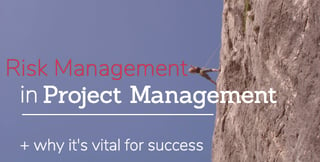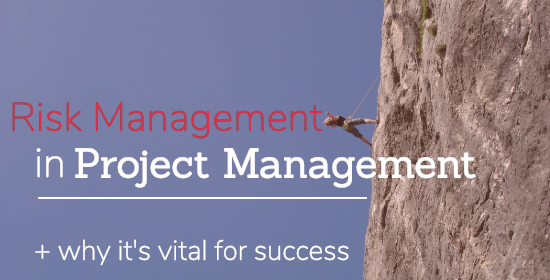What is Risk Management in Project Management & Why It's Vital to Success


Strategy is vital for any successful business. Results keep a business going. But bridging the gap between strategy and results lies one key element: project management. Businesses run on projects. Our days are filled with deadlines and task lists and milestones. Projects are how businesses make money—and how they lose money too. According to the Project Management Institute (PMI),
- Each year, only 45 percent of projects meet their goals.
- 45 percent of all projects are either overdue or canceled completely.
- 9.9% of every dollar is wasted due to poor project performance.
PMI also tells us that for every $100 invested in projects, organizations experience a net loss of $13.50.
When it comes to projects in business, the odds are not in our favor.
And it’s not that we’ve come to embody the lazy and entitled millennial cliché—we’re working more than ever. Today’s business environment is full of new technology automating and streamlining tasks, giving us more time to handle bigger or more complicated issues. There seem to be unending tools, tricks, and tips for successful project management. And yet, we miss deadlines, we don’t align with goals and purpose, and projects go unfinished.
So how do we help increase our ability to make our projects reach goals on time and within budget? That’s where risk management comes in.
What is risk management in project management?
Every project, no matter the size, faces a certain amount of risk in meeting goals and getting to completion. Uncertainties exist that can bring positive or negative outcomes. These can be outside risks like a government shut down or inside risks like miscommunication among team members. In a marketing campaign, some of the most common risks include miscommunication or disagreement among key stakeholders, lack of alignment between marketing and sales teams, miscommunication among the internal team, and stalled process due to outside parties (lag in approval or not fulfilling resources promised).
How do you assess and manage risk as a project manager (or unofficial project manager) to ensure your project is a success without burning out your team or yourself trying to control every possible outcome? You need a risk management plan.
How to implement a risk management plan for your projects
Risk management in project management is an iterative process. To help ensure success, it’s important to implement a risk management framework in your project management process.
Whether “project manager” is in your title or it manages to fill your job description without official acknowledgment, knowing and understanding the five Project Management Process Groups will be critical to your success and the success of the projects you manage.
The five process groups in project management include:
- Initiate
- Plan
- Execute
- Monitor & Control
- Close
In the “Initiate” phase, you build the foundation of your entire project. Here, you will identify and establish clear expectations for the project’s success and how that success will be measured. This is typically achieved by performing stakeholder interviews and establishing a project scope statement. This process will also include setting a timeline, organizing teams, sourcing required materials, and setting up any other necessary items that are necessary for the project’s success.
This is also where the project manager will identify potential risks in the project, and it’s a key process group for successful risk management.
Building a risk management map
Just like you map out your project in the “Plan” phase of the process groups, you need to map out your project risks in the “Initiate” phase. Here are the steps you need to make a risk management map.
Identify
Get together with your team and brainstorm possible risks you see with a project, both inside and outside of your control. Remember risk management in project management is about identifying uncertainties that bring about positive or negative outcomes. This means not all risks are inherently bad! It’s up to the team to identify both threats to your project’s success and opportunities for your project to succeed.
Evaluate and prioritize
After you’ve identified possible risks, describe what the impact would be on your project should this risk come to fruition. You’ll want to assign a value to each risk—this could be high, medium, and low or a numbered scale—to assess the weight of impact this risk has on your project and its ability to be completed on time and achieve its purpose. Not all risks are created equal, but this value system will help you prioritize the risks in your project.
After you’ve evaluated all potential threats and opportunities, it’s time to prioritize which risks are most important to mitigate first and identify what order risks may need to be addressed to ensure other risks don’t develop down the road. One threat may be worth risking if the value of the potential opportunity far outweighs it.
Assign ownership
Next, identify who “owns” each risk. A marketing manager may be responsible for managing stakeholder expectations and keeping them up-to-date on the happenings of the project, whereas a content creator may be responsible for getting stakeholder interviews scheduled, and a designer is responsible for getting the right branding files in time to complete their part of the project. Whatever the risk is, the owner is responsible for managing the risk and driving the response if something throws a wrench into plans.
Plan your response
You can’t avoid every possible risk. And if you spend all your time and energy assessing and avoiding, there won’t be much left for executing on your actual project and moving it toward your goals. Things will happen outside of your control, and while it’s important to mitigate risk as much as possible from the beginning, you also need to have a response plan for when the unexpected does inevitably occur. Using the owners you’ve assigned, define how you will respond to each risk should it occur or show potential signs of occurring. This way, when something happens, you don’t have to waste any time figuring out what to do and who’s responsible. You’re armed and ready to take on the obstacle or opportunity.
Relax
With this mapped out, you’ve spent designated time identifying risks with your team, so now you can release yourself from the need to constantly obsess over what else could possibly go wrong in the project. Honestly, I suggest grabbing a beer with the team once you’ve completed this step to truly allow yourselves to let go of the other “what ifs” you may not have gotten on your risk management map. True, something may happen that isn’t on your map. But if you’ve spent intentional time establishing your risk management framework, chances are more likely that you’ll burn yourself out thinking about what could go wrong than any chance that the one thing you didn’t think of does happen. And hey, if it does, you’re prepared to handle it.
Keep evaluating
Now that we cleared that up, it’s worth noting one last thing. Just because you mapped out all the possible risks that could influence the outcome of your project doesn’t mean you’re good to go. The risk management map isn’t a “set it and forget it” tool—it’s an iterative process, remember? This map should be constantly revisited and reviewed throughout the lifetime of the project. You need to evaluate how these risks are playing out in the project: has something else changed in the project that could increase or decrease the chance of a risk? Have you reached a milestone within the project that could remove the risk from the project? Have new elements entered or changed the scope of your project that may introduce new risks? Continue to review the risks against the status of your project, evaluating and prioritizing along the way.
PMI’s Pulse of the Profession 2018 says it best: “Smart organizations understand that proven project management practices lead to greater success and less waste. They give support, stay focused, and deliver results.”
If you want your project to be successful, you have to be prepared to mitigate and respond to the risks it faces. Having a risk management map takes the guesswork out of project management.

